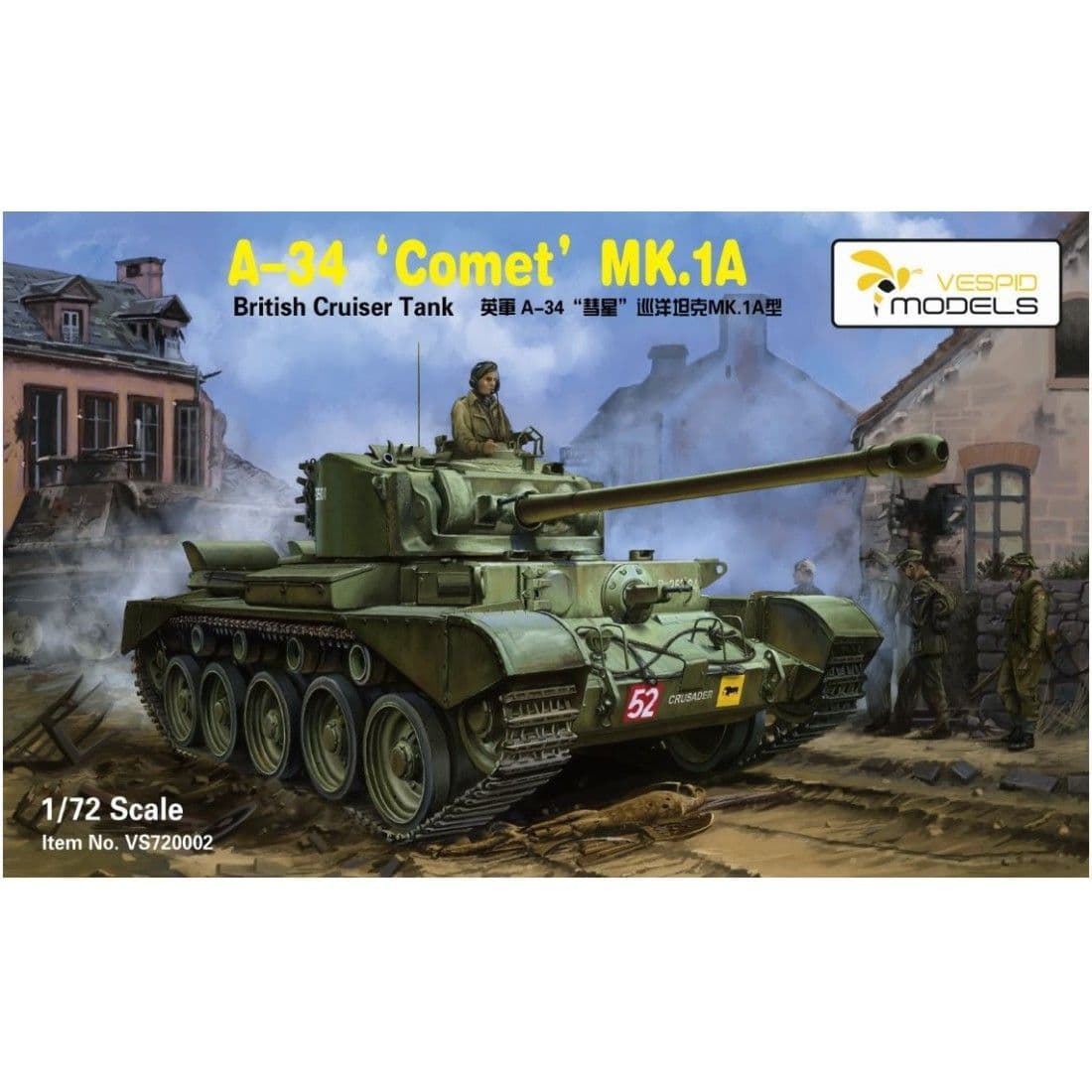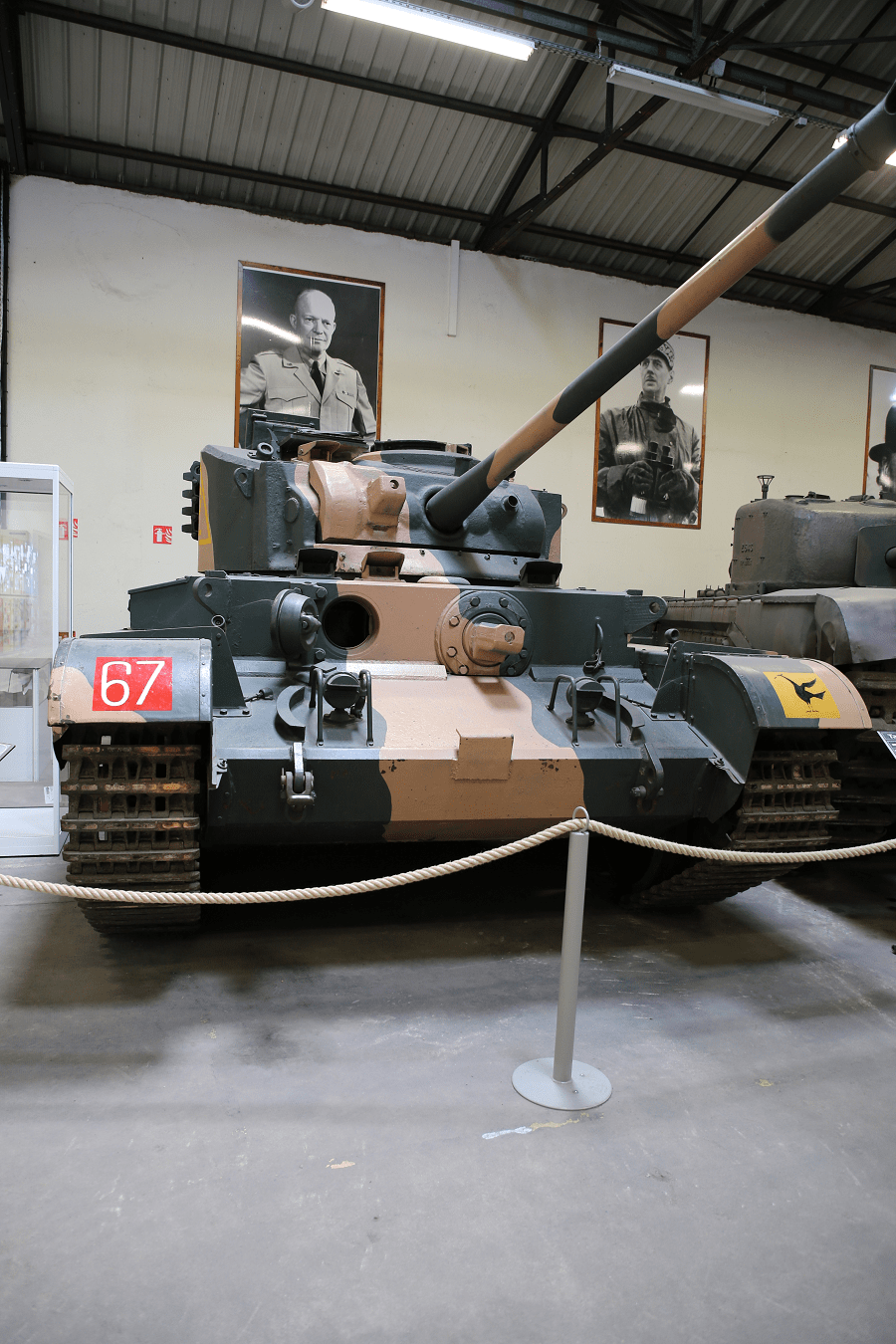Comet British Tank - The A34 Cruiser Comet was the first British tank delivered from September 1944 (until the end of World War II) and used in England until 1958. The Comet was the successor to the Cromwell and was part of the Cruiser series of tanks.
The Comet improved the Challenger and led to the development of the Centurion tank. A new 77mm VN gun was installed in the lower profile and new turret. The new gun was effective against the Panther at medium range and sometimes against the Tiger 1 at close range. Due to lack of funds, they tried to use as many parts as possible from the Mk VI Crusader.
Comet British Tank

After a while, the British realized that their cruiser tanks were not effective enough. They demanded new heavy cruiser tanks that could match the German models. For economic reasons, as many parts as possible from the then A15 Cruiser Mk VI Crusader tank were used. The first designs evolved into the A24 Cruiser Tank Mk VII Cavalier and the Cruiser Tank Mk VII Centaur.
Vs720002 British Cruiser Tank A34 Comet Mk Ia
The Cromwell had a number of new front sections. The new Meteor engine proved reliable and gave the tank good maneuverability. However, some problems arise from significant jumps in engine performance. The tank was prone to shedding rails if rail tension was not properly maintained. There were also some suspension issues, probably due to the high speeds. Cromwell therefore went through a number of design changes.
The biggest mistake had to do with fire. The Cromwell was originally designed to carry the 57mm Ordnance QF 6 pounder. In combat, they were useful to other tanks, but without explosive charges they were not effective enough.
There were several attempts to improve the firepower by installing a powerful weapon. During the development of the Cromwell and QF 75mm guns, the new Vickers High Velocity 75mm tank gun was developed. This proved too great for Cromwell. The first version of the 17lb led to the production of the A30 Cruiser Mk VIII Challenger. According to Cromwell, it was necessary to lengthen the hull and mount a large turret on top to accommodate a second 17-pounder loader.
A tall turret was mandatory for some guns, leading to experiments with the similar A30 Avenger.
Tamiya 1/35 Scale A34 Comet Plastic Model Kit Review
The upgrade from the Sherman to the Sherman Firefly (17lb) was faster than Challenger production and was driven by the needs of the Normandy invasion Challenger production. A firefly would be issued to every army. (these are three Cromwells and one Sherman Firefly)
Sherman Firefly Vickers Light Tank Tetrarch Crusader Cromwell Matilda I Matilda II Valentine Churchill Covenanter Challenge This article lists general links but lacks sufficient content to match the table of contents. Please help improve this article by introducing more understandable text. (April 2009) (Learn how and how to remove this message template)
The Tank Comet or Tank, Cruiser, Comet I (A34) was a British cruiser tank first used at the end of World War II, during the Western Allies' invasion of Germany. The Comet was developed from the original Cromwell tank and fitted with a new 17 pdr High Velocity (HV) gun (3 in; 76.2 mm – sometimes called "77 mm"). This gun was effective against late war German tanks, including the medium Panther and Tiger.

The Comet replaced the obsolete Cruiser Mk VIII Challenger and led to the development of the Cturion tank. The 77 mm HV, firing APDS rounds, exceeded the ammunition capacity of the 75 mm KwK 42 gun of the equivalent Axis tank, the Panther.
Model Tank: A 34 Comet Mk.1
The Comet entered service in January 1945 and remained in British service until 1958. In some cases Comets sold to other countries remained in service into the 1980s.
The experience of fighting the Germans in the Western Desert campaign showed the British many faults with their cruiser tanks. So in 1941, a request was made for a new heavy cruiser tank that could gain combat superiority over the German models. For reasons of economy and efficiency, he had to use as many parts as possible from the current A15 Mk VI Crusader tank.
Early designs for the new Cromwell tank evolved into the A24 Mk VII Cavalier tank and the A27L Mk VIII Ctaur tank, both operated by Nuffield Liberty. The design progressed through the Mk VII (A27M) Cromwell, the third parallel upgrade of the Cavalier and Ctaur, sharing many of the same characteristics.
Cromwell has incorporated several advanced features into the new A27M specification. The Meteor engine proved to be very reliable and gave the tank good maneuverability, but some problems were noted due to the common heritage of the car and the large jump in engine power. The tank would throw tracks if the track was not handled properly or if it moved too fast or too fast. There were also some collision stopping problems, partly due to the Cromwell's speed, and it underwent many design changes as a result.
A34 Comet Tank
The main complaint was about fire; The Cromwell was originally designed to carry the 57mm Ordnance QF 6-pounder, converted to Crusader tanks. In combat they proved useful against some tanks, but without any meaningful explosives they were ineffective against anti-tank guns or static emplacements. Prior to the Cromwell's combat service, the Ordnance QF 75mm was introduced, equipping most Cromwells, a modified version of the 6lb rounds from the American 75mm Sherman gun. This provided less anti-tank performance than the 6-pounder, but its much larger casing provided a more effective explosive charge.
Several attempts were made to further improve the firepower by installing a powerful gun. Building on the development of the Cromwell and QF 75mm guns, a new Vickers High Velocity 75mm gun was developed, but proved too large for the Cromwell's turret ring, leaving it lacking in anti-tank capability.
The need for the first 17-pounder tank gun led to the development of the A30 Mk VIII Challenger. According to Cromwell, the hull had to be flattened and a very large turret placed on top to allow a second loading for the 17-pounder, a requirement of the old order which was considered necessary for the larger guns. The very tall turret of the Challenger was considered a burden and this led them to experiment with a similar version of the A30 Avger, an anti-tank version with an op-top turret.

The transition from Sherman tanks to the Sherman Firefly (a Sherman tank equipped with a 17-pounder gun) was faster than Challenger production, and driven by the operational needs of the Normandy invasion, Challenger production declined. Fireflies (and a small number of Challengers) provided additional firepower to Cromwell's and Sherman's armed forces. One Firefly would be assigned to each Cromwell group (giving three Cromwells and one Sherman Firefly). Problems were calculated due to the difference in maintenance requirements and the delivery mix of both types of tanks, as well as the difference in performance between the Cromwell and the Sherman and the silhouette of the Sherman being larger than the Challger. The sheer size and obvious difference between the Charger and Firefly made them a target for Axis forces.
Srd35908 1:35 Star Decals
Realizing that a joint vehicle was needed to replace the combined fleet of Cromwell, Challenger and Firefly tanks, a new form of tank was developed. This eliminated the need for a second Challenger charge and installed the new Vickers high-velocity gun designed for the Cromwell.
With the A34 tank (Geral Staff designation), later called the Comet, tank designers set out to correct some of the Cromwell's shortcomings in armament, track design and suspension, building on its strengths of low height, high speed and mobility. This replaced the need for the Challenger and Firefly and was what was achieved through the design and initial deployment of the Cromwell.
The Cromwell was originally expected to use a Vickers "High Velocity 75 mm" gun, but this did not fit in the turret.
Gun production continued and when work began on the Comet, gun production changed to the 17 pdr HV (High Velocity).
Revell 1/76 British Medium Cruiser Tank \
The gun now used a projectile of the same caliber (76.2 mm) as the 17-pounder, but the cartridge from the old QF 20 cwt 3-inch anti-aircraft gun was loaded to a higher pressure. The charge differed from the 17-pounder, being shorter, more compact, and easier to store and handle inside the tank. Tests on the line by the 2nd Fife and Forfarshire Yeomanry, as they turned away from the Shermans, showed that the gun did not hit the front plate of a captured German Panther tank.
The 17 pdr HV was a short 17-pounder. This allowed the gun to be mounted on a smaller turret ring. The weapon was still capable of counterattack and APDS fire
Tank comet, british crusader tank, british cruiser tank a34 comet, british tank tea maker, british tank, british flag tank top, british comet tank, british conqueror tank, british comet, british de havilland comet, comet tank model, british mark iv tank

0 Comments